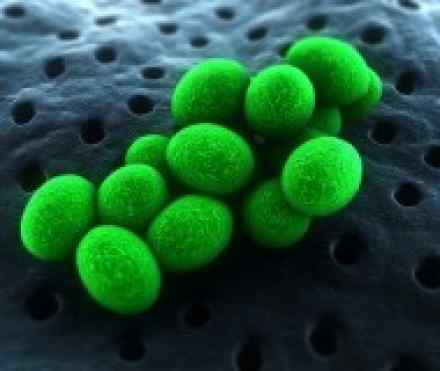
What is it?
Staph infections are caused by staphylococcus bacteria, a type of germ commonly found on the skin or in the nose of even healthy individuals. Most of the time, these bacteria cause no problems or result in relatively minor skin infections.
But staph infections don't always remain skin-deep. In some circumstances, they may invade your bloodstream, urinary tract, lungs or heart.
Severe staph infections usually occur in people who are already hospitalized or who have a chronic illness or weakened immune system. But it is possible for otherwise healthy people to develop life-threatening staph infections.
Symptoms
Staph infections can range from minor skin problems to endocarditis, a life-threatening inflammation of your heart valve lining. As a result, signs and symptoms of staph infections vary widely, depending on the location and severity of the infection.
Skin infections
Skin infections caused by staph bacteria include:
- Boils. The most common type of staph infection is the boil, a pocket of pus that develops in a hair follicle or oil gland. The skin over the infected area usually becomes red and swollen. If a boil breaks open, it may drain pus, blood or an amber-colored liquid. Boils occur most often under the arms or around the groin or buttocks.
- Impetigo. This contagious, often painful rash can occur in all ages, but it is most common in young children and infants. The types of impetigo caused by staph bacteria usually feature large blisters that may ooze fluid and develop a honey-colored crust. These sores occur most commonly around the nose and mouth.
- Cellulitis. This type of infection causes the skin to look red and swollen, to the point that the hair follicles create dimples similar to the appearance of an orange peel. Cellulitis occurs most often in the lower legs and feet of older persons.
- Scalded skin syndrome. Affecting mostly newborns, this condition features fever, a rash and sometimes blisters. When the blisters break, the top layer of skin comes off — leaving a red, raw surface that looks like a burn.
Food poisoning
Signs and symptoms of staph-related food poisoning usually come on quickly — as soon as one to six hours after you've eaten contaminated food. The illness often leaves just as suddenly as it came, and most people recover in a day or two, though the effects can be more serious and longer lasting in children and older adults. Symptoms include:
- Abdominal cramps
- Nausea
- Vomiting
- Diarrhoea
Bacteremia
Also known as blood poisoning, bacteremia occurs when staph bacteria enter a person's bloodstream. A persistent fever is one sign of bacteremia. The bacteria can travel to locations deep within your body, to produce infections affecting:
- Internal organs, such as your heart (endocarditis) or lungs (pneumonia)
- Surgically implanted devices, such as artificial joints or cardiac pacemakers
Toxic shock syndrome
This life-threatening condition has been linked to the use of certain types of tampons and, less often, to skin wounds and surgery. It usually develops suddenly, with:
- High fever
- Nausea and vomiting
- A rash on your palms and soles that resembles sunburn
- Confusion
- Muscle aches
- Seizures
- Headache
Septic arthritis
Septic arthritis is often caused by a staph infection. The bacteria usually target the knees, but other joints can be affected, including your ankle, hip, wrist, elbow or shoulder. Symptoms may include:
- Joint swelling
- Severe pain in the affected joint
- Fever
- Shaking chills
Causes
Many people carry staph bacteria and never develop staph infections. If you have a staph infection, there's a good chance that it stemmed from bacteria you've been carrying around for some time.
These bacteria also can be transmitted from person to person. Because staph bacteria are so hardy, they can live on inanimate objects like pillowcases or towels long enough to transfer to the next person who touches them.
Staph bacteria are able to survive:
- Drying
- Extremes of temperature
- High levels of salt
- Even cooking won't kill the toxins produced by staph bacteria, which is why they can cause food-borne illness.
Risk factors
A variety of factors — ranging from the status of your immune system to the types of sports you play — can increase your risk of developing staph infections.
Current or recent hospitalization
Despite vigorous attempts to eradicate them, staph bacteria remain widespread in hospitals, where they attack the most vulnerable, including people with:
- Weakened immune systems
- Burns
- Surgical wounds
- Serious underlying health problems, such as diabetes
Invasive devices
Staph bacteria can travel along the medical tubing that connects the outside world with your internal organs. Examples include:
- Dialysis
- Urinary catheters
- Feeding tubes
- Breathing intubation
- Intravascular catheters
Contact sports
Staph bacteria can spread easily through cuts, abrasions and skin-to-skin contact. Amateur and professional athletes have spread staph infections by sharing razors, towels, uniforms or equipment.
Complications
If staph bacteria invade your bloodstream, you may develop a type of infection that affects your entire body. Called sepsis, this infection can lead to septic shock — a life-threatening episode of extremely low blood pressure.
Diagnosis
Most often, doctors diagnose staph infections by checking a tissue sample or nasal secretions for signs of the bacteria.
References
http://www.medicinenet.com/staph_infection/article.htm
http://www.webmd.com/skin-problems-and-treatments/guide/staph-infection-cellulitis
http://www.mayoclinic.org/diseases-conditions/staph-infections/basics/treatment/con-20031418
http://www.nhs.uk/conditions/staphylococcal-infections/Pages/Introduction.aspx







